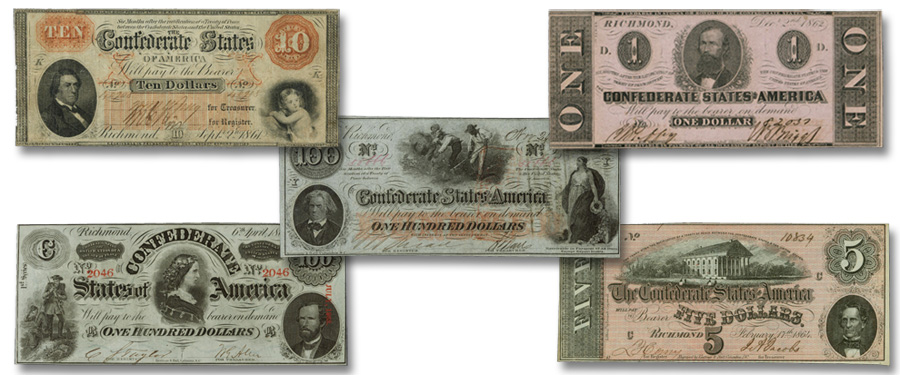
During the American Civil War, the Confederate States of America issued their own circulating paper money for use in daily commerce. Notes were produced in various types from 1861 to 1864. Due to the challenges of unstable supply lines, lack of reliability, military encroachment and other factors, the Confederate government employed numerous different firms for the production of Confederate treasury notes. Certainly the most prodigious producer of these notes was the firm of Leggett, Keatinge & Ball.
In August of 1861 Edward Keatinge, an Englishman who worked as an engraver for the American Bank Note Company, relocated to Richmond, Virginia upon receiving an offer from the Confederate government to establish a printing firm. Keatinge partnered with Thomas Ball, a lawyer, who was invited by Confederate Treasury Secretary C.G. Memminger to join in the founding of the firm. Keatinge and Ball were joined in September 1861 by William Leggett (also formerly an employee of the American Bank Note Company) who specialized in lettering.
With the firm ready to begin operations in Richmond, their first order of business was to produce desperately needed $5 and $10 bills. Quickly they altered a steel plate originally used on $5 notes for the Mechanics Savings Bank of Savannah, Georgia, removing the bank title and adding the required Confederate clauses and banner. The resulting product is now known as Confederate Type 32, a scarce 1861 dated $5 note. At the same time they produced a newly designed $10, now known as Type 24. Type 32 carried the printer’s imprint of Leggett, Keatinge & Ball Richmond, VA as did Type 24 for a while. In March 1862 Leggett was forced out of the company after Secretary Memminger’s accusation that Leggett had been associated with a Union spy. Keatinge & Ball continued with the company, removing Leggett’s name.
After the Type 32 was printed, all later versions of the $5 denomination produced by Keatinge & Ball actually featured the portrait of Secretary Memminger. These include Types 33, 34, 53, 60 and 69. Due to the quality of their work Keatinge & Ball gained the bulk of the Confederate’s currency business by 1862 and from 1863 on produced all Confederate treasury notes except for the 50 cent denomination. The company induced skilled engravers from England to travel to the British West Indies and then be transported to Confederate ports aboard blockade runners, no doubt a harrowing journey. However the engravers were well paid, and in gold rather than paper currency.
With supplies in the Confederate States scarce the company utilized contacts in the North and abroad to import much needed reams of paper for printing notes. Among these paper types were the famous "NY" countermarked paper as seen on Types 21 and 24. Other papers were imported by the Confederacy and used by Keatinge & Ball including "TEN" and "FIVE" watermarked paper, Hodgkinson & Co. Wookey Hole Mill, J Whatman 1862, J Green & Son 1862, and "CSA" block letter surrounded by wavy line watermarks. These paper types make up the numerous varieties available to be collected today.
With the Union army approaching Richmond, Keatinge & Ball relocated their operation to Columbia, South Carolina in May 1862. Soon after Keatinge was the sole engraver of Confederate notes in denominations of $1 to $500. Ball ran the administrative side of the business and provided some of the firm’s financial backing. The company continued producing notes up through the Series of 1864 notes. In February of 1865 Keatinge quit the business after continued disagreements with the Confederate government and Keatinge & Ball was dissolved.
Among possessions found in assassinated president Abraham Lincoln’s possessions on April 15, 1864, was a Type 69 Series of 1864 $5 Confederate treasury note produced by Keatinge & Ball.





